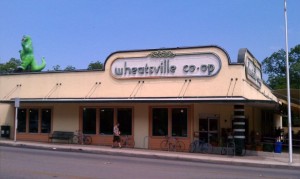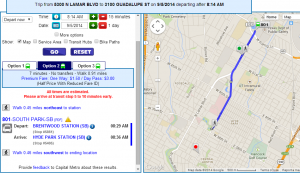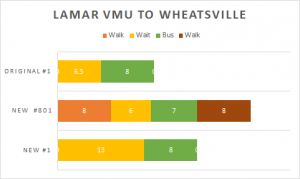This VMU on Lamar at North Loop (google maps link; as of 9/5/2014 the streetview picture is from construction) is open now. I like it. It has a bus stop right in front of it! Streetscape is good. There’s actually a new Taco Cabana across North Loop from it, unfortunately with a drive-thru, where the pretty image to the right has a grassy field1. The property to the south of the Taco Cabana appears ripe for redevelopment soon as another VMU; I’d be surprised not to see it go that way within a couple of years.
Let’s imagine the resident of one of these new apartments wants to take the bus to Wheatsville Co-Op, an urban grocer located at about 31st and Guadalupe. Lots of people used to ride the bus to Wheatsville last I checked.
For background, the VMU ordinance was enacted as a quid-pro-quo for the McMansion ordinance – the logic was that we would build tall apartments (for Austin, anyways) over walkable retail on corridors where transit frequencies and usefulness was high. Lamar/Guadalupe definitely fit that bill, at least originally.
Before the implementation of “Rapid Bus”, the #1 ran about every 13 minutes during peak periods on this route. Google maps says that the bus portion of this trip takes 8 minutes on the #1. Note that Google doesn’t even consider the 801 a viable option for this trip, unlike Capital Metro themselves. We’ll get to that in a minute.
We can use the same “show up and go” calculations from this post to come up with this graph. Short summary: If transit service is to be truly useful as a replacement for the car, it needs to be frequent enough that you don’t bother to check a schedule; you just show up at the stop and a bus comes pretty soon (and by the way this was one of the big marketing points for the #801; so this isn’t just a condition I’m placing on them to be mean). Note that the walking time on either end for the #1 trip is essentially zero – there are bus stops for the #1 (but not the #801) directly in front of the VMU building and the grocer.
Originally, when frequency was every 13 minutes, a trip to the grocery store would involve a 0 minute walk, an average 6.5 minute wait (half of frequency), and a 8 minute trip on the bus, for an expected trip time of 14.5 minutes. Not bad.
However, in the world we live in now, Capital Metro has cut half of the #1s and imposed instead the #801 in place of the #101, stealing the local frequency for the express. How does that service work for our apartment resident?
Same calculations as above – we end up with an expected wait of 13 minutes (it runs every 26 minutes during peak)2. Total trip time is now 21 minutes, if you can get a seat on this bus, which has been a problem ever since the 801 change happened.
But surely the 801 made up for this drop in service, right?
Again, Google won’t even give this as a trip; but Capital Metro’s trip planner does.
Huh. Cap Metro expects the user of this ‘service’ to walk about a half mile north to the “Brentwood Station”, wait (12 minute frequencies during peak), ride the bus to the “Hyde Park Station” (7 minutes), then walk about a half mile south to Wheatsville. Hey Google, how long will those walks take? Google says 8 minutes each, roughly.
So let’s graph those new trips, shall we?
The results show that, and all of this is compared to the conditions before the #801 started (“old #1” in the graph), a resident of this apartment building can now either pay the same amount of money for a much less frequent service (#1) that will now take about 50% longer to get where they want to go, or they can pay double the price for a reasonably frequent service (#801) that will take more than twice as long to go where they want to go. People boarding a bus at this stop and travelling to Wheatsville have seen a significant degradation in quality of bus service.
What’s the conclusion? Well, even if you are foolish enough to think a 26 minute frequency local service still qualifies as “show up and go”, the residents of this VMU and many others in the area are unquestionably much worse off after the implementation of MetroRapid. And what’s worse – the developments resulting from the VMU ordinance were sold to surrounding neighborhoods as less of an impact on their daily lives because we all assumed many of its residents would ride the bus.
Still true? Doubt it.
More to come.


